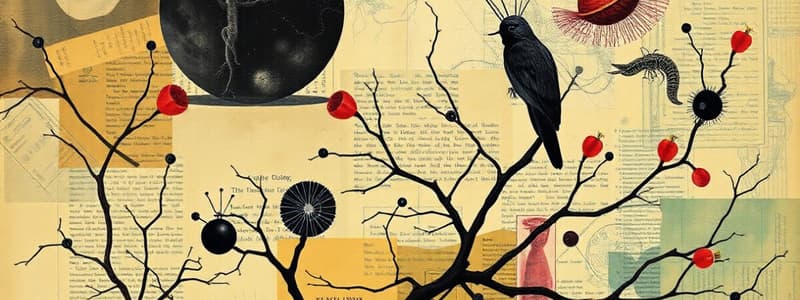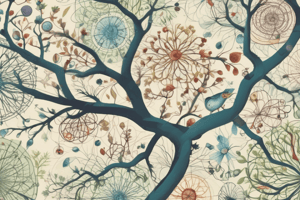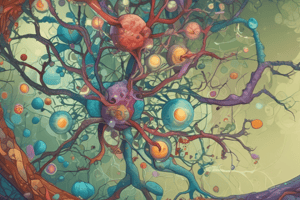Podcast
Questions and Answers
Which of the following branches of biology focuses on the study of microorganisms?
Which of the following branches of biology focuses on the study of microorganisms?
- Microbiology (correct)
- Botany
- Zoology
- Genetics
What is the function of the mitochondria in a cell?
What is the function of the mitochondria in a cell?
- Site of protein synthesis
- Powerhouse of the cell (correct)
- Contains genetic material
- Involved in lipid synthesis
What does a gene represent in genetics?
What does a gene represent in genetics?
- A type of chromosome
- A segment of DNA that codes for a protein (correct)
- A segment of RNA
- A base pair of DNA
Which statement best describes natural selection?
Which statement best describes natural selection?
What type of cells are characterized as simple and lacking a nucleus?
What type of cells are characterized as simple and lacking a nucleus?
What are decomposers responsible for in an ecosystem?
What are decomposers responsible for in an ecosystem?
How many chromosomes do humans have?
How many chromosomes do humans have?
Which organ system is primarily responsible for gas exchange in the human body?
Which organ system is primarily responsible for gas exchange in the human body?
Flashcards are hidden until you start studying
Study Notes
Key Concepts in Biology
-
Definition: Biology is the study of life and living organisms, encompassing various aspects such as structure, function, growth, evolution, and distribution.
-
Branches of Biology:
- Botany: Study of plants.
- Zoology: Study of animals.
- Microbiology: Study of microorganisms.
- Ecology: Study of interactions between organisms and their environment.
- Genetics: Study of heredity and variation in organisms.
- Molecular Biology: Study of biological processes at the molecular level.
Cell Biology
-
Cell Theory:
- All living organisms are composed of cells.
- The cell is the basic unit of life.
- All cells arise from pre-existing cells.
-
Types of Cells:
- Prokaryotic: Simple, no nucleus (e.g., bacteria).
- Eukaryotic: Complex, with a nucleus (e.g., plants, animals).
-
Cell Organelles:
- Nucleus: Contains genetic material (DNA).
- Mitochondria: Powerhouse of the cell, produces energy (ATP).
- Ribosomes: Site of protein synthesis.
- Endoplasmic Reticulum: Involved in protein and lipid synthesis.
- Golgi Apparatus: Modifies, sorts, and packages proteins.
Genetics
-
DNA Structure:
- Double helix composed of nucleotides (adenine, thymine, cytosine, guanine).
-
Gene: A segment of DNA that codes for a protein.
-
Chromosomes: Structures made of DNA and proteins; humans have 46 chromosomes (23 pairs).
-
Mendelian Genetics:
- Dominant and Recessive Traits: Dominant alleles mask the effect of recessive alleles.
- Punnett Squares: Tool for predicting genetic outcomes.
Evolution and Natural Selection
-
Theory of Evolution: Proposed by Charles Darwin; explains the diversity of life through descent with modification.
-
Natural Selection: Mechanism of evolution where organisms better adapted to their environment tend to survive and reproduce.
Ecology
-
Ecosystem: A community of living organisms and their physical environment.
-
Biomes: Large ecological areas with distinct climates and organisms (e.g., deserts, rainforests).
-
Food Chains and Food Webs:
- Producers: Organisms that make their own food (e.g., plants).
- Consumers: Organisms that eat other organisms.
- Decomposers: Organisms that break down dead material.
Human Biology
-
Organ Systems:
- Circulatory System: Transports blood and nutrients.
- Respiratory System: Responsible for gas exchange.
- Nervous System: Controls and coordinates body activities.
-
Homeostasis: The ability of an organism to maintain stable internal conditions despite external changes.
Microbiology
-
Bacteria: Single-celled prokaryotic organisms; can be beneficial or pathogenic.
-
Viruses: Acellular infectious agents that require a host to replicate.
-
Fungi: Eukaryotic organisms that decompose organic material and can be unicellular (yeasts) or multicellular (molds).
Biodiversity
-
Importance: Biodiversity contributes to ecosystem stability, resilience, and provides resources for food, medicine, and materials.
-
Conservation: Efforts to protect and preserve biodiversity, including habitat preservation and restoration.
Key Concepts in Biology
- Biology examines life, including structure, function, growth, evolution, and distribution of organisms.
- Major branches of biology include:
- Botany: Study of plant life.
- Zoology: Study of animal life.
- Microbiology: Study of microorganisms.
- Ecology: Study of interactions between organisms and their environment.
- Genetics: Study of heredity and variation in living beings.
- Molecular Biology: Analysis of biological processes at the molecular level.
Cell Biology
- Cell Theory encompasses three principles:
- All living organisms are made of cells.
- The cell is the fundamental unit of life.
- All cells arise from pre-existing cells.
- Cell types include:
- Prokaryotic: Simple cells lacking a nucleus, such as bacteria.
- Eukaryotic: Complex cells with a nucleus, found in plants and animals.
- Key cell organelles:
- Nucleus: Houses genetic material (DNA).
- Mitochondria: Produces energy (ATP), known as the cell's powerhouse.
- Ribosomes: Sites for protein synthesis.
- Endoplasmic Reticulum: Involved in protein and lipid synthesis.
- Golgi Apparatus: Modifies, sorts, and packages proteins.
Genetics
- DNA features a double helix structure made of nucleotides (adenine, thymine, cytosine, guanine).
- A gene is a DNA segment coding for proteins.
- Chromosomes, made of DNA and proteins, are present in pairs; humans have 46 chromosomes (23 pairs).
- Mendelian Genetics principles:
- Dominant traits can overshadow recessive traits.
- Punnett Squares are tools for predicting genetic outcomes.
Evolution and Natural Selection
- Charles Darwin proposed the Theory of Evolution, explaining life's diversity through modifications over generations.
- Natural Selection describes how organisms better adapted to their environment tend to survive and reproduce.
Ecology
- An ecosystem comprises living organisms and their environmental interactions.
- Biomes are large ecological regions with specific climates and life forms, such as deserts and rainforests.
- Food Chains and Food Webs illustrate:
- Producers: Organisms that generate their own food (e.g., plants).
- Consumers: Organisms that consume others for energy.
- Decomposers: Organisms that recycle nutrients by breaking down dead material.
Human Biology
- Organ systems include:
- Circulatory System: Transports blood and nutrients throughout the body.
- Respiratory System: Facilitates gas exchange (oxygen and carbon dioxide).
- Nervous System: Manages and coordinates bodily functions.
- Homeostasis is the maintenance of stable internal conditions despite external changes.
Microbiology
- Bacteria are single-celled prokaryotes, which can be beneficial or harmful.
- Viruses are acellular agents that need a host to reproduce.
- Fungi are eukaryotic organisms that decompose organic matter, existing as unicellular (yeasts) or multicellular (molds).
Biodiversity
- Biodiversity supports ecosystem stability and resilience while providing essential resources for food, medicine, and materials.
- Conservation efforts aim to protect and preserve biodiversity through habitat preservation and restoration initiatives.
Studying That Suits You
Use AI to generate personalized quizzes and flashcards to suit your learning preferences.




